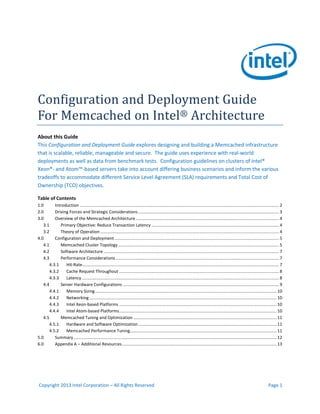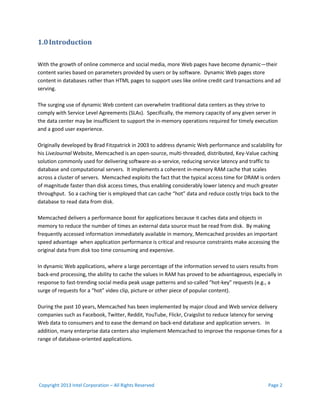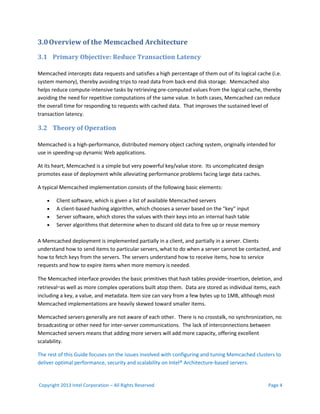This guide details the design and deployment of a memcached infrastructure on Intel® architecture for scalable and efficient web data management. It addresses real-world implementation, hardware configurations, and performance optimization to meet varying service level agreement (SLA) requirements. By leveraging in-memory caching, memcached significantly reduces transaction latency and enhances application performance in high-demand environments.












![Copyright 2013 Intel Corporation – All Rights Reserved Page 13
6.0Appendix A – Additional Resources
“Ways to Speed-Up Your Cloud Environment” blog post
“Enhancing the Scalability of Memcached” technical paper
P. Saab, "Scaling Memcached at Facebook," 12 December 2008. [Online]. Available:
https://www.facebook.com/note.php?note_id=39391378919&ref=mf
Twitter Engineering, "Memcached SPOF Mystery," Twitter Engineering, 20 April 2010. [Online].
Available: http://engineering.twitter.com/2010/04/Memcached-spof-mystery.html
Reddit Admins, "reddit's May 2010 "State of the Servers" report," Reddit.com, 11 May 2011.
[Online]. Available: http://blog.reddit.com/2010/05/reddits-may-2010-state-of-servers.html
C. Do, "YouTube Scalability," Youtube / Google, Inc., 23 June 27. [Online]. Available:
http://www.youtube.com/watch?v=ZW5_eEKEC28
Memcached.org, "Memcached- a distributed memory object caching system,"
Memcached.org, 2009. [Online]. Available: http://Memcached.org/about](https://image.slidesharecdn.com/164916-configuration-130910074941-phpapp02/85/Configuration-and-Deployment-Guide-For-Memcached-on-Intel-Architecture-13-320.jpg)
